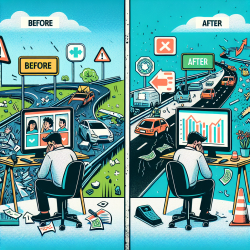Introduction
At TinyEYE, our mission is to provide exceptional online therapy services to schools, ensuring that children receive the best possible outcomes. While our focus is on speech and language pathology, we can draw valuable insights from diverse fields of research to enhance our practice. One such area is the study of crash severity, which offers data-driven insights that can be applied to our work.
Understanding the Research
The research paper titled Impact of Driver’s Age and Gender, Built Environment, and Road Conditions on Crash Severity: A Logit Modeling Approach explores the relationship between crash severity and various factors, including driver demographics, built environment, and road conditions. The study employs a logit model to analyze these variables and their impact on crash outcomes.
Key Findings and Implications
The research reveals several key findings that can inform our approach to online therapy:
- Driver Demographics: The study highlights the significance of age and gender in crash severity. For instance, younger and older drivers exhibit different risk profiles. This insight can be applied to tailor therapy sessions based on age-specific needs and characteristics.
- Built Environment: The built environment, including urban and rural settings, plays a crucial role in crash outcomes. Similarly, in therapy, understanding the environmental context of our clients can help us design more effective interventions.
- Road Conditions: Road conditions, such as icy or slippery surfaces, significantly affect crash severity. In therapy, considering external factors that may impact a child's progress, such as school environment or family dynamics, can enhance our interventions.
Applying the Insights to Online Therapy
By integrating these insights into our online therapy practice, we can improve outcomes for children:
- Customized Interventions: Just as the research identifies specific risk factors for different driver demographics, we can customize therapy interventions based on individual characteristics and needs.
- Environmental Considerations: Understanding the built environment's influence on crash severity can inspire us to consider environmental factors in therapy, such as the child's home or school setting.
- Data-Driven Decisions: The use of a logit model in the research underscores the importance of data-driven decision-making. We can leverage data analytics to assess therapy effectiveness and make informed adjustments.
Encouraging Further Research
While this research provides valuable insights, it also highlights the need for ongoing exploration. Practitioners are encouraged to delve deeper into how external factors influence therapy outcomes and to consider interdisciplinary approaches to enhance their practice.
To read the original research paper, please follow this link: Impact of Driver’s Age and Gender, Built Environment, and Road Conditions on Crash Severity: A Logit Modeling Approach.










